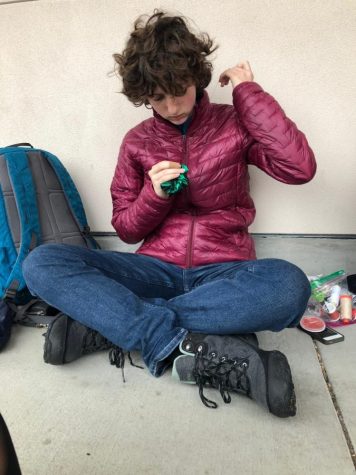The innovative and creative outlets around campus
March 10, 2019
You go to the store. You scour the shelves for that perfect item you’re looking for — the one with the right color, the right size, the right look. You smile, satisfied, as you put the item in the cart, proceeding to the checkout.
For most of us, that’s how we attain the products of our daily lives and hobbies. We buy our surfboards, our scrunchies A our blankets. But not for all, not for the three individuals below who unleash their creativity in their unique crafts.
Hajela:

Last summer, sophomore Sumer Hajela began creating his own surfboards. His hobby originated from his dad’s passion for surfing, which had got him to start surfing five years ago. He spent the summer assembling and constructing surfboards and a bike for his friend.
“It’s a combination of creation and having a passion,” Hajela said. “When those two things come together, it’s this total feeling of accomplishment.”
So far, Hajela has made seven surfboards. He does not make the surfboards from scratch, as they cost a significant amount of money and take time to fully construct and refurbish. He buys materials from shops Billabong and Rip Curl, which includes custom fins, leashes and pads, which he then adds to the board to assemble a full surfboard. To customize each board he assembles, he paints them and adds a finish.
“One of them I just splatter painted it because they give you the board and it’s just pure white, so you have the choice [to paint it],” Hajela said. “One of them my dad laminated finish with red and yellow. When I get older and I have a job I can make some really nice ones.”
Hajela uses his creations to surf the waves of O’Neill beach in Capitola. Hajela describes that the best part of his hobby is the relaxed vibe and “chill atmosphere” that both surfing and making surfboards have.
“I’ll definitely teach my kids how to surf,” Hajela said. “And I’ll definitely teach them how to make [surfboards] because it’s just a really fun hobby.”
Johnson:
Whether it’s out of yarn, wood, flour or metal, Art teacher Jody Johnson loves to create. In college, she focused on metal and jewelry design, but has now shifted over to knitting and crocheting. Her grandma, also a knitter, passed away in 2010. This event, along with the fact that many of her students knitted in their free time, led Johnson to try out the activity herself.
“The first thing I ever made was actually a crocheted little beanie thing that one of my students taught me how to make,” Johnson said. “I like to knit because it’s just something that fills time for me.”
Recently, Johnson finished an Afghan blanket she has been working on for the past few years. It cost her about 300 dollars and took her five years to finish. It would’ve taken less time had Johnson consistently worked on it, but because she is involved with other types of arts and crafts, knitting is not always her first priority. Despite this, she enjoys making things from scratch because she believes that the end result — holding the item that she made with her own hands — is worth it.
“I get a lot of satisfaction out of just knowing that I created that thing, whatever it is,” Johnson said. “Everybody can buy something. You have to have a little something else to be able to have the patience and the skill to make something.”
In the future, Johnson wants to make more eco-friendly items, for she believes that the end product is representative of the effort and compassion she puts into her projects. Johnson also plans to create new stockings for every newborn that enters her family’s life.
“My dad made [stockings] when we were kids,” Johnson said. “He made my mom’s, my dad’s, mine, my brothers and my sisters. Somehow the job got passed down to me. Whenever a new baby is born in the family, or when someone gets engaged or someone in the family gets married, and we add a new family member that way, I make their stockings. I have two new stockings to add to the family this year.”
Johnson believes that the story behind each piece someone commissions from an artist is worth more than, as well as the satisfaction someone gains from making something by hand. She believes that hobbies like are “dying art” and not many people are exploring crafts as much as people have in the past.
“You get a piece and it’s really old, and it’s going to have nicks and chips and dents in it,” Johnson said. “A lot of people will spend a ton of time trying to sand out those imperfections, but I think those imperfections are the things that show its history. I think they’re almost as important than having something that’s totally machine fabricated… I feel sad that I think a lot of these things are kind of dying art.”
Shanna and Lana Goldman:
Last November, sophomore Shanna Goldman was browsing Pinterest when she found a picture of a homemade scrunchie. She decided to use some of the extra fabric laying around in the house to make a scrunchie herself, knowing that it was a relatively easy process and that she would probably not mess it up.

So she went to work — she made a scrunchie, gave it to her twin Lana Goldman, who wore the scrunchie to school. Her friends all liked it, and from there they began SickScrunchies, a local business organization that sells scrunchies to high school girls.
“Originally, I was just going to give the scrunchies away, but it takes a good chunk of my time and I have to pay for the fabric, so I started charging,” Shanna said. “They’re not that expensive, just enough so I can keep making them.”
Their business operates like this — a potential buyer DMs the twins through their Instagram account, giving a description of what type and color of scrunchie he or she would like, and the twins get to work, cutting out the fabric, sewing them with a machine, putting the elastic through them and then hand sewing the final product.
Shanna takes about 10 minutes to make one scrunchie, but because she usually makes five to 10 at a time, it takes between one to two hours in total.
As of now, the twins have no future plans for their business.
“The only people who are going to be buying them are high school students,” Lana said. “My dad tried to ask his friends if they want them and it’s just not the right demographic, and it really does appeal to high school girls. We’re thinking of doing middle college next year and if we’re not on campus it’s harder to sell to people.”
Additional reporting by Rucha Soman.

















